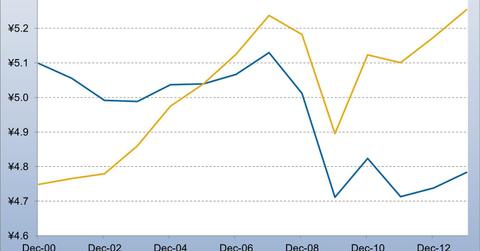Japan’s GDP back to peak levels: Auto sales and Toyota benefit
This article considers the prospects for further real GDP growth acceleration and the implications for Japanese exporters like Toyota.
Nov. 22 2019, Updated 6:49 a.m. ET

Whats good for Toyota is good for Japan
The below graph reflects trends in Japan’s Gross Domestic Product (GDP) measured in real (inflation adjusted) and nominal terms (non-inflation adjusted). Japan’s population is approximately 128 million people, versus the U.S. population of 316 million people (approximately 40% of the U.S. population, on a land mass 11% smaller than California). Japan has a GDP per capita of approximately $37,000, while the U.S. has a GDP per capita of approximately $45,000, based on year 2000 level constant prices. Like GDP itself, Japan’s GDP per capita is also back to its pre-2008 crisis peak levels. This article considers the prospects for further real GDP growth acceleration and the implications for Japanese exporters like Toyota.
The yen weakens, GDP grows—more pressure for China and Korea?
For China and Korea, a continued weakening of the yen could begin to erode their relatively lower cost base advantage, leading to a readjustment of the “terms of trade” between these regional economies. In other words, the relative competitiveness between countries is driven by both the cost basis and productivity of the domestic economy, and when one currency weakens in relation to another, the resulting drop in the domestic price level can provide a competitive advantage in lowering the costs of production, and enhance export competitiveness. China has benefitted from this “terms of trade” advantage for many years, as its currency has been pegged to a fairly weak U.S. dollar, although it has gradually appreciated against the U.S. dollar over the years. Japan has seen its terms of trade eroded for many years as its currency has been appreciating aggressively against the U.S. dollar for many years.
China’s currency peg is good for Toyota and Japanese exporters
As the Japanese currency is free to trade in the global currency markets, its ability to weaken rapidly can be its advantage—as it has been since 2012. The Japanese yen has weakened against the dollar and the euro, enhancing export competitiveness, while the Chinese yuan has continued to gradually appreciate in a managed exchange rate regime—Japanese yen down, Chinese yuan up—which is great for Japanese exporters. With the rapidly expanding wages in China, Japan’s production costs levels will likely get close to China’s within five years. Should that be the case, Japanese auto makers like Toyota, Honda, and Nissan may increase domestic production in a big way, and support a stronger Japanese economy.
To see how the Japanese yen has weakened dramatically against the Chinese yuan, the Korean won, the U.S. dollar, and the euro, read the next article in this series.
For an overview of the April 1, Bank of Japan Beige Book on Japan’s economic outlook, read Bank of Japan Tankan supports a 2014 equity rally in Japan.
Japan’s equity outlook
As 2014 progresses, investors could see a continued outperformance of Wisdom Tree Japan Hedged (DXJ) and the iShares MSCI Japan ETF (EWJ) versus China’s iShares FTSE China 25 Index Fund (FXI) and Korea’s iShares MSCI South Korea Capped Index Fund (EWY). Plus, as Japan pursues unprecedented monetary expansion, and the U.S. Fed tapers its bond purchases, Japanese equities could also outperform the broad U.S. equity indices, as reflected in the State Street Global Advisors S&P 500 SPDR (SPY), State Street Global Advisors Dow Jones Index SPDR (DIA), and Blackrock iShares S&P 500 Index (IVV).
